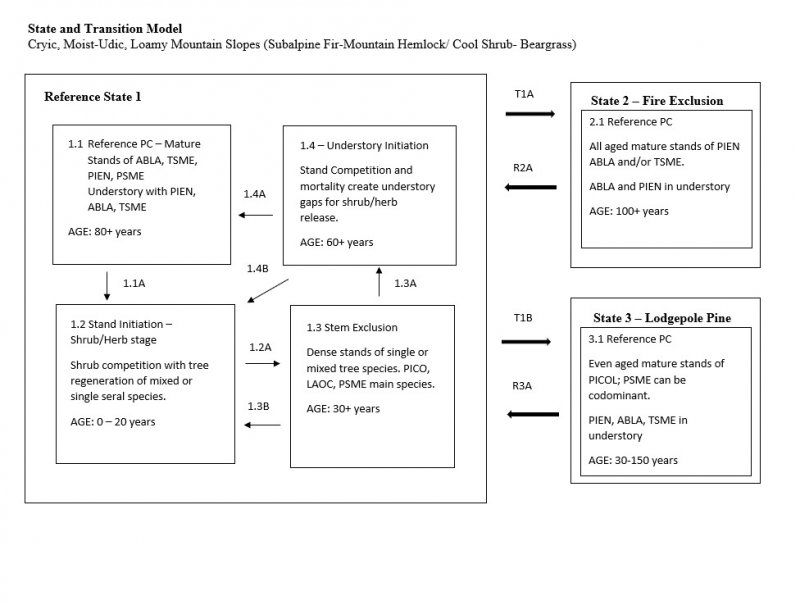
Natural Resources
Conservation Service
Ecological site F043AY583ID
Cryic, Moist-Udic, Loamy, Mountain slopes, Ashy surface Subalpine Fir-Mountain Hemlock/ Menziesia -Beargrass
Last updated: 10/15/2020
Accessed: 12/18/2025
General information
Provisional. A provisional ecological site description has undergone quality control and quality assurance review. It contains a working state and transition model and enough information to identify the ecological site.
MLRA notes
Major Land Resource Area (MLRA): 043A–Northern Rocky Mountains
Major Land Resource Area (MLRA): 043A–Northern Rocky Mountains
Description of MLRAs can be found in: United States Department of Agriculture, Natural Resources Conservation Service. 2006. Land Resource Regions and Major Land Resource Areas of the United States, the Caribbean, and the Pacific Basin. U.S. Department of Agriculture Handbook 296.
Available electronically at: http://www.nrcs.usda.gov/wps/portal/nrcs/detail/soils/ref/?cid=nrcs142p2_053624#handbook
LRU notes
Most commonly found in LRU 43A10 (Clearwater Mountains). Also found in areas of 43A11 (Bitterroot Metasedimentary Zone). Climate parameters were obtained from PRISM and other models for the area. Landscape descriptors are estimated from USGS DEM products and their derivatives.
Classification relationships
Relationship to Other Established Classifications:
United States National Vegetation Classification (2008) – A3614 Abies lasiocarpa – Picea engelmannii Rocky Mountain Forest & Woodland Alliance
Washington Natural Heritage Program. Ecosystems of Washington State, A Guide to Identification, Rocchio and Crawford, 2015 – Subalpine – Montane Mesic Forest
Description of Ecoregions of the United States, USFS PN # 1391, 1995 - M333 Northern Rocky Mt. Forest-Steppe-Coniferous Forest-Alpine Meadow Province
Level III and IV Ecoregions of WA, US EPA, June 2010 – 15r Okanogan-Colville Xeric Valleys and Foothills, 15w Western Selkirk Maritime Forest, 15x Okanogan Highland Dry Forest, 15y Selkirk Mountains.
This ecological site includes the following USDA Forest Service Plant Associations: Abies lasiocarpa Series; ABLA/MEFE and ABLA/XETE Habitat Types and Tsuga mertensiana Series; TSME/MEFE and TSME/XETE Habitat Types. (Cooper et al., 1987)
Ecological site concept
This ESD in distinguished by an overstory of subalpine fir or mountain hemlock and an understory shrub component of menzesia and huckleberry. On some exposures shrubs are absent and beargrass dominates the understory. It occurs on upper slopes of mountainsides, and ridges. These soils have developed in thick (>7 inches) Mazama tephra deposits over local till or residuum and colluvium from granitic and metamorphic rock. The soils range from moderately deep to very deep and have adequate available water capacity to a depth of 40 inches. The soils are moderately well or well-drained. Water tables, when present, are perched and >30 inches below the surface during May-Oct. This ESD fits into the National Vegetation Classification’s Subalpine Fir - Engelmann Spruce Rocky Mountain Moist Forest Alliance and Washington State Natural Heritage Program’s Rocky Mountain Subalpine Mesic-Wet Spruce-Fir Forest.
Table 1. Dominant plant species
| Tree |
(1) Abies lasiocarpa |
|---|---|
| Shrub |
(1) Menziesia ferruginea |
| Herbaceous |
(1) Xerophyllum tenax |
Click on box and path labels to scroll to the respective text.
